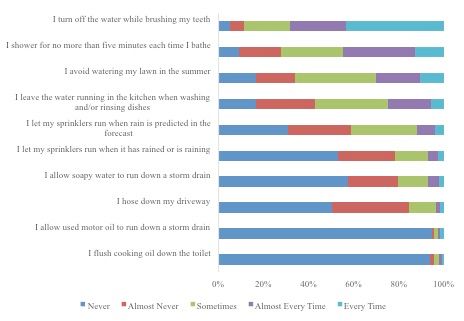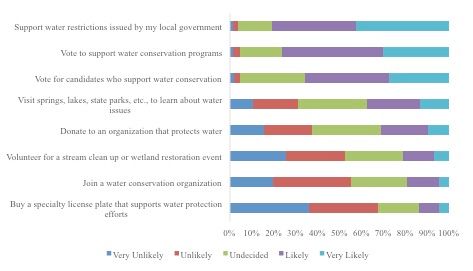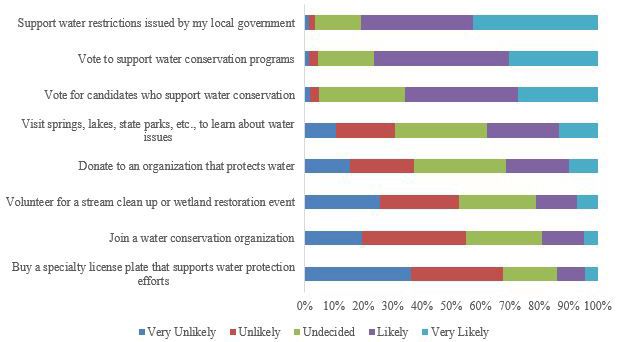Introduction
Approximately 50% of Floridians' daily water consumption is used for outdoor purposes, such as landscape irrigation; this is 20% higher than the national average (South Florida Water Management District, 2008; United States Environmental Protection Agency, 2016). In order to alleviate the pressure on the precious water resources in Florida from various demands, increased public awareness and engagement in water conservation is needed, especially among high water users. High water users are a specific group of homeowners who are actively engaged in landscape irrigation and have in common particular demographic characteristics and behavioral patterns (Huang, Lamm, & Dukes, 2016; Monaghan, Ott, Wilber, Gouldthorpe, & Racevskis, 2013). Understanding high water users' behavioral patterns can help Extension educators target their programming to this important audience (Kotler & Roberto, 1989; Monaghan et al., 2013). This EDIS document is the second in a series discussing how Extension can improve high water users' engagement in water conservation with a focus on high water users' water-related behavior and willingness to act. The entire series includes the following EDIS documents:
- High Water Users' Experiences and Perceptions of Water (https://edis.ifas.ufl.edu/publication/WC255)
- High Water Users' Water-Related Behaviors and Willingness to Act (https://edis.ifas.ufl.edu/publication/WC256)
- High Water Users' Opportunities to Learn about Water Conservation (https://edis.ifas.ufl.edu/publication/WC257)
High water users are typically residents of a neighborhood with a homeowners association (HOA). They tend to be older in age and have a higher income and education level than the general public (Huang et al., 2016; Monaghan et al., 2013). High water users are also unique in their behaviors associated with landscaping management. They are likely to hire a contractor to manage their landscape instead of managing their own and are less engaged in water-conserving landscape irrigation practices (Davis & Dukes, 2014; Huang et al., 2016).
An online survey developed to examine respondents' opinions about water was distributed electronically to Florida high water users living in the Orlando area (N = 512), Tampa/Sarasota area (N = 219), and Miami/Fort Lauderdale area (N = 201). Data were collected from 3,494 invited individuals, resulting in 932 complete responses and a participation rate of 27%. Detailed demographics of the respondents in this study can be seen in the first document of the series: https://edis.ifas.ufl.edu/publication/WC255.
Water Use Behaviors
High water users were asked about how often they engage in a series of water-related behaviors. They were presented with a series of statements related to water use and asked to indicate their level of engagement by selecting never, almost never, sometimes, almost every time, or every time (Figure 1). Sixty-eight percent of the respondents saved water when brushing their teeth almost every time or every time, and 45% saved water by taking shorter showers almost every time or every time.
In terms of their landscape, only 29% avoided irrigating their lawns in the summer almost every time or every time, while more than 50% never or almost never run their sprinklers when rain is predicted in the forecast and when it has rained or is raining. When talking about behaviors associated with household cleaning, 43% of the respondents never or almost never left the water running in the kitchen when washing and/or rinsing dishes; 75% never or almost never allowed soapy water to run down a storm drain; and 83% never or almost never hosed down their driveways. Lastly, for behaviors associated with oil waste management, 88% of the respondents never or almost never allowed used motor oil to run down a storm drain, and 93% of them never or almost never flushed cooking oil down the toilet.

Water Conservation Strategies
High water users' application of water conservation strategies can be seen in Figure 2. More high water users applied water-conserving practices inside the home when compared to practices for landscaping. Within the water conservation strategies for landscaping uses, around 40% of the respondents had installed high efficiency sprinklers and/or smart irrigation controllers, but only 12% of them had installed drip irrigation. While 42% of the respondents planted low water-consuming plant materials in their yards, only 17% had retrofitted a portion of their landscape with no need of irrigation. Finally, while only 8% of the respondents used rain barrels to collect water for landscaping use, 23% of them used recycled wastewater to irrigate their lawn/landscape.

Willingness to Act
High water users were asked about their willingness to act to protect water in the future. Respondents were asked to indicate how likely or unlikely they were to engage in 22 behaviors in the future that can be divided into two major types: life-related water conservation behaviors (Figure 3) and societal water conservation behaviors (Figure 4).
Life-Related Water Conservation Behaviors
More than 95% of the respondents indicated they were likely or very likely to dispose of hazardous materials responsibly. As for household cleaning, more than 85% were willing to save water by running dishwashers and washing machines only when they are full and sweeping patios and sidewalks instead of hosing them down, while 70% of them were willing to use biodegradable cleaning products. Regarding outdoor activities, 67% were willing to reduce their use of natural resources. When asked about behaviors associated with landscaping water use, the behavior with the most respondents willing to act was for watering their lawns only in the morning or evening. While more than 70% of the respondents were willing to avoid purchasing plants that require a lot of water and reduce the number of times they water their lawns during a week, a relatively lower amount (about 50%) were willing to install efficient irrigation technology and reduce use of fertilizer and pesticides if that meant their landscape quality would decrease. Additionally, only 34% were willing to modify their landscape so that a portion is not irrigated. However, fewer respondents (18%) were willing to keep a timer in the bathroom to remind them to take shorter showers.

Societal Water Conservation Behaviors
For societal behaviors associated with water conservation, more than half of the respondents were willing to support water restrictions issued by their local governments and vote for water conservation programs and candidates who support water conservation. While 38% of the respondents were willing to visit natural resources to learn about water issues, 31% were willing to donate to an organization that protects water. About 20% were willing to volunteer for a stream clean up or wetland restoration event and join a water conservation organization. Lastly, only 14% were willing to buy a specialty license plate that supports water protection efforts.

Discussion
Many high water users have engaged in water conservation to a certain degree. However, they engaged in water conservation behaviors associated with personal and household cleaning more than landscaping, which is where they use an excessive amount of water. Most high water users are willing to conserve water inside the home and engage in water consumption reduction strategies for their landscapes as long as they do not have a negative impact on their landscapes. As for societal water conservation behaviors, high water users tend to be more willing to engage in behaviors with authority involved, such as supporting government-issued water restriction and voting to support water conservation programs or for candidates who support water conservation.
Extension educators should be aware of high water users' high concerns regarding landscape quality. There is also a large gap between their current engagement in landscape water conservation behaviors and their willingness to be engaged in certain landscape water conservation actions. High water users showed interest and desire to conserve water to a certain degree. Efforts should be made to develop educational programs that address this gap by providing behavioral change recommendations based on their needs and interests. For example, changing daily landscape irrigation schedules to have sprinklers run only in the morning (Trenholm, Unruh, & Cisar, 2013) would be a suggested landscaping water-saving strategy that more high water users are willing to adopt. Programs with materials and strategies that are easy to practice and relevant to a target audience's (i.e., high water users') needs may be more effective in increasing the adoption of water-conserving practices (Huang et al., 2016).
References
Davis, S. L., & Dukes, M. D. (2014). Methodologies for successful implementation of smart irrigation controllers. Journal of Irrigation and Drainage Engineering. Retrieved from https://ascelibrary.org/doi/pdf/10.1061/%28ASCE%29IR.1943-4774.0000804
Huang, P., Lamm, A. J., & Dukes, M. (2016). Informing extension program development through audience segmentation: Targeting high water users. Journal of Agricultural Education, 57(2), 60–74. doi: 10.5032/jae.2016.02060
Kotler, P., & Roberto, E. L. (1989). Social marketing. Strategies for changing public behavior. New York, NY: The Free Press.
Monaghan, P., Ott, E., Wilber, W., Gouldthorpe, J., & Racevskis, L. (2013). Defining audience segments for extension programming using reported water conservation practices, Journal of Extension 51(6). Retrieved from https://tigerprints.clemson.edu/joe/vol51/iss6/8/
South Florida Water Management District. (2008). Water conservation: A comprehensive program for South Florida. Retrieved from https://www.sfwmd.gov/sites/default/files/documents/waterconservationplan.pdf
Trenholm, L. E., Unruh, J. B., & Cisar, J. L. (2013). Watering your Florida lawn. ENH9. Gainesville: University of Florida Institute of Food and Agricultural Sciences. Retrieved from https://edis.ifas.ufl.edu/publication/LH025
United States Environmental Protection Agency. (2016). Water use today. Retrieved from https://www.epa.gov/watersense/how-we-use-water